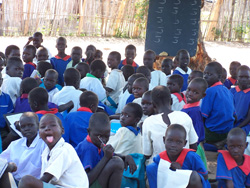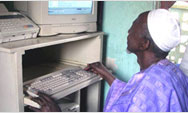You are here » Home » Telling Our Story
First Person
Southern Sudan rebuilds its education system, from the ground up
Teachers In Demand

| |
Photo: AED
Children learn to read at Rejaf Primary School in Juba, Southern Sudan.
|
|
“We still have hindrances such as the lack of teacher guides, and the lack of teacher accommodation, especially in rural areas, but these things take time, and with help, we can meet our challenge,” said John Aguek, director of teacher training at Southern Sudan’s Education Ministry.
|
John Aguek faces an enormous challenge. As the director of teacher training at Southern Sudan’s Education Ministry, he is tasked with managing the recruitment and training of teachers for one of the poorest, most under-educated regions in the world.
Two decades of civil war took their toll on Sudan’s school system. Today, only one in six Southern Sudanese can read, only 22 percent of children go to school, and only 2.3 percent of students complete primary school. Among girls, only 11 percent have access to school and just 1 percent complete primary school.
John Aguek has set out to improve the current teaching force and enlist new teachers to meet the growing need. “We had an education system that lacked innovation, quality, and relevance,” Aguek said. “We need good teachers, but first we have to recruit them, and that’s a big challenge.”
USAID is helping him. Since 2002, USAID has renovated, built, and expanded teacher education institutions in Maridi, Aramweer, Arapi, and Panyagor, and developed a unified curriculum for pre- and in-service teacher education. Eight thousand in-service teachers will be trained at USAID-supported county education centers, which serve as local training hubs.
Since women make up two-thirds of the population, encouraging female students and teachers is crucial. In 2005 and 2006, USAID awarded 2,600 scholarships to high school girls to encourage them to stay in school, and a teachers’ code of conduct is being developed to provide gender-sensitive guidelines to create a safe environment for female instructors.
USAID has also provided education experts to help the Education Ministry support planning and management. One expert works directly with Aguek to formulate a teacher education strategy for practical, effective, and rapid training.
John Aguek has taken on a gargantuan task, but with USAID’s help he is confident he will succeed: “Before I received assistance from [USAID] advisors, I thought my task was too large to manage. Now we are all working cooperatively towards the same goal.”
Print-friendly version of this page (416kb - PDF)
Click here for high-res photo
Back to Top ^ | 

